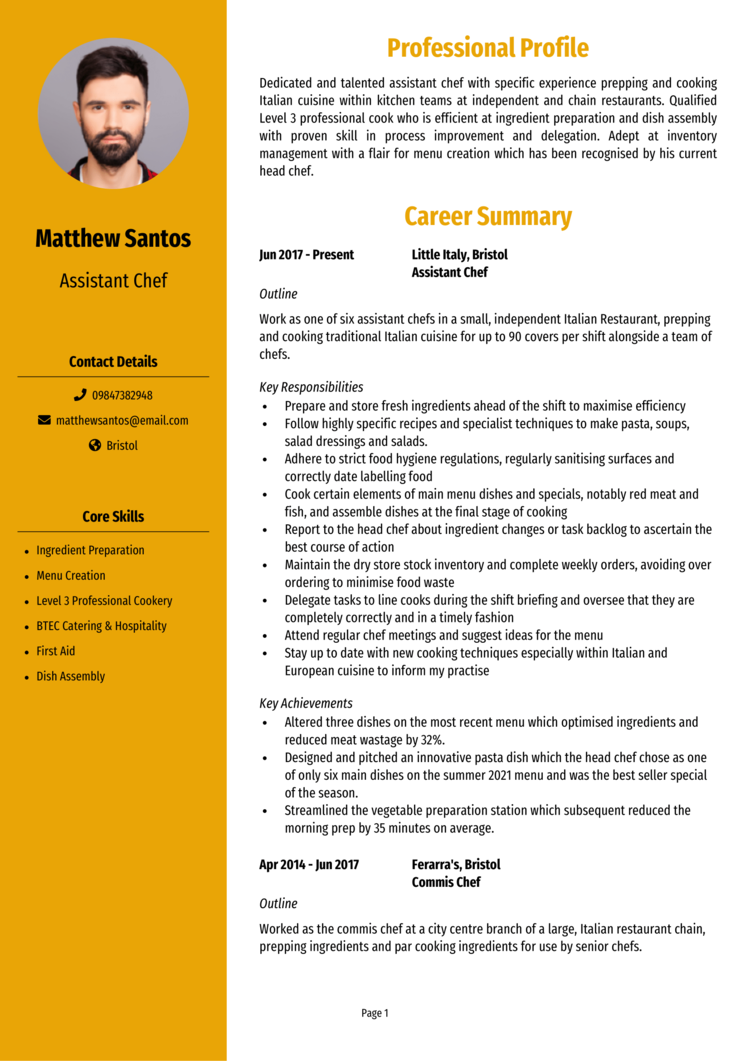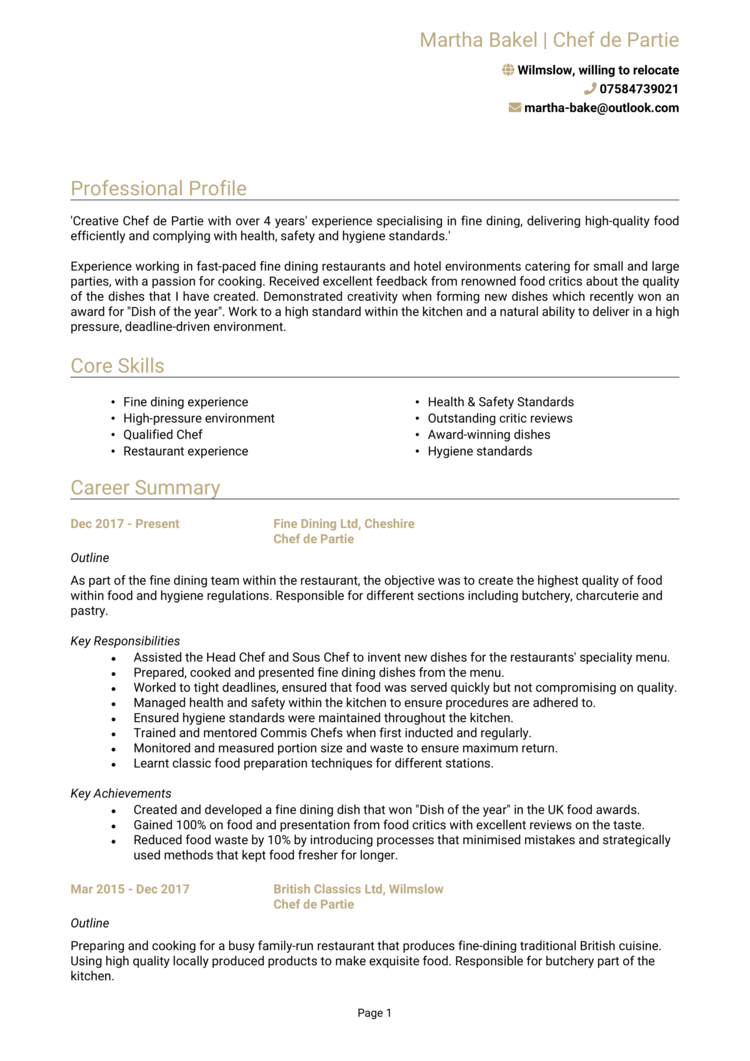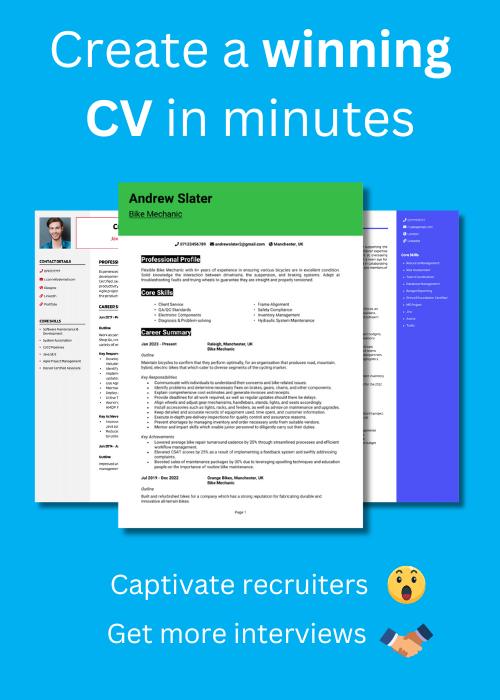Are you ready to whip up the perfect CV and turn up the heat on your job search?
As a chef, your culinary skills can make any dish shine, but before you step into your next kitchen, you’ll need a CV that’s seasoned to perfection. Recruiters are hungry for candidates who can balance creativity, teamwork, and efficiency in the heat of the kitchen.
This guide, complete with expert tips and some Chef CV examples, will show you how to serve up an application that leaves hiring managers wanting seconds.
Chef CV example

Head Chef CV example

Executive Chef CV example

Assistant Chef CV example

Chef De Partie CV example

Junior Sous Chef CV example

Pastry Chef CV example

Pizza Chef CV example

Sushi Chef CV example

How to write your Chef CV
Learn how to create your own interview-winning Chef CV with this simple step-by-step guide.
This guide will walk you through writing a Chef CV that highlights your culinary expertise, kitchen management skills, and ability to work under pressure. By the end, you’ll have a CV that looks good enough to plate up and serve to any employer.
Chef CV structure


Your CV needs to be as well-prepped as your mise en place. Recruiters want to quickly see your cooking techniques and contributions to memorable dining experiences: they’ll struggle to find them if your CV is poorly organised.
Here’s how to structure your Chef CV:
- Name and contact details – Keep these at the top for quick reference. Adding a photo is purely optional.
- CV profile – Start with a concise summary of your culinary experience, specialities, and key achievements.
- Core skills – Give a quick overview of your strengths, like menu planning, food safety, and staff supervision.
- Work experience – Detail your roles in reverse chronological order, focusing on your key responsibilities and accomplishments.
- Education – Walk through your academic qualifications like degrees, culinary certifications, and any relevant training.
- Additional info – You can optionally discuss hobbies and interests, awards, or special dietary knowledge (e.g., vegan or gluten-free).
Formatting your Chef CV


Think of your CV like your signature dish: it should look as good as it reads. Its format should reflect the precision and presentation you bring to your dishes: even the most experienced chef can be overlooked if their CV is a mess.
Follow these tips to format your Chef CV effectively:
- Bullet points – Use these to break down responsibilities and achievements into concise details.
- Divide sections – Clear headings and layout help hiring managers quickly navigate your CV.
- Use a clean font and subtle colour scheme – Keep the font and design choices professional and easy to read.
- Keep it under 2 pages – Focus on your most relevant skills and experience to keep the recruiter’s attention: no need to pad it out with unnecessary fluff.
Chef CV profile


Your CV profile is your chance to whet the recruiter’s appetite for the rest of your application. For a Chef, this section should highlight your culinary skills, creativity, and ability to run a kitchen efficiently.
Chef CV profile examples
Profile 1
Creative Chef with six years of experience in fine dining restaurants, skilled in crafting innovative dishes and managing kitchen operations. Proficient in menu development, food safety standards, and leading teams to deliver exceptional culinary experiences.
Profile 2
Efficient Chef with four years of experience in high-volume catering, adept at preparing large-scale meals while maintaining quality and consistency. Experienced in inventory management, cost control, and training junior staff in kitchen protocols.
Profile 3
Dedicated Chef with over eight years of expertise in casual dining, specialising in creating seasonal menus, sourcing fresh ingredients, and ensuring seamless day-to-day operations. Skilled in supervising kitchen staff, maintaining hygiene standards, and accommodating dietary needs.
What to include in your Chef CV profile
Tailor your profile to the role by focusing on the experiences and specialities that match the employer’s needs.
What to include in your Chef CV profile:
- Where you’ve worked – Mention restaurants, hotels, or catering services you’ve contributed to.
- Your top qualifications – Highlight culinary certifications, such as NVQ in Professional Cookery or a diploma from a recognised culinary school.
- Cooking expertise – Include specialities like French cuisine, pastry work, or grill expertise.
- Kitchen management experience – Reference your ability to lead teams, manage inventory, and ensure food safety compliance.
- Customer focus – Mention how you’ve contributed to guest satisfaction or created memorable dining experiences.
What to include in a Chef CV core skills section


Your core skills section is like your ingredient list: it tells recruiters exactly what you bring to the table. Highlight your technical, organisational, and leadership abilities.
You might well be a “dynamic and passionate go-getter” but recruiters simply don’t value those generic cliches – focus on tangible, hard skills that prove you know what you’re doing.
Need help crafting a chef CV that highlights your skills?
Check out our CV builder for professional templates, pre-written content, and expert tips to help you cook up the perfect application.
Top skills for your Chef CV
- Menu Development – Designing creative menus that balance cost, flavour, and presentation.
- Cooking Techniques – Mastery of grilling, sautéing, baking, and other essential methods.
- Food Safety and Hygiene – Ensuring compliance with health and safety regulations, including HACCP protocols.
- Inventory Management – Tracking stock, minimising waste, and ordering supplies efficiently.
- Staff Supervision – Leading and training kitchen teams to maintain high standards.
- Special Diets – Creating menus for vegan, gluten-free, and allergen-sensitive customers.
- Time Management – Delivering high-quality meals under tight deadlines.
- Customer Interaction – Tailoring dishes to guest preferences and ensuring satisfaction.
- Event Catering – Preparing and serving meals for weddings, banquets, and corporate events.
How to highlight work experience


Your work experience section is where you demonstrate your ability to thrive in fast-paced kitchens and deliver outstanding results. Focus on roles that showcase your culinary expertise, leadership, and contributions to the dining experience.
List your roles in reverse chronological order. If you’re newer to the field, include internships, apprenticeships, or volunteer roles in kitchens.
How to structure jobs

- Outline – Provide a brief overview of the establishment, your role, and the type of cuisine or dining experience offered.
- Responsibilities – Highlight tasks like food preparation, staff coordination, or menu creation. Use action verbs like “prepared,” “oversaw,” or “led.”
- Achievements – Mention measurable outcomes, such as increasing customer satisfaction, reducing food costs, or earning positive reviews. Quantify where possible (e.g., “catered events for 200+ guests with consistently positive feedback”).
Example jobs for Chef
Chef | Luxuriant Dining
Outline
Served as a Chef in a fine dining restaurant, responsible for creating high-quality dishes, overseeing kitchen staff, and maintaining food safety standards. Focused on delivering an exceptional dining experience.
Responsibilities
- Designed and prepared creative menus with seasonal and locally sourced ingredients.
- Led a team of 10 kitchen staff, ensuring efficient operations during busy service hours.
- Maintained strict adherence to food hygiene and safety regulations.
- Managed inventory and coordinated with suppliers to maintain fresh stock.
- Collaborated with front-of-house staff to ensure customer satisfaction and smooth service.
Achievements
- Reduced food waste by 20% through effective inventory management.
- Introduced a signature dish that increased menu sales by 25%.
- Received recognition for excellence in a local dining award programme.
Chef | EatGood Catering Agency
Outline
Worked as a Chef for a catering company, preparing large-scale meals for corporate events and private functions. Focused on maintaining quality and efficiency under tight deadlines.
Responsibilities
- Prepared high-volume dishes while adhering to specific client requirements and dietary restrictions.
- Developed detailed meal plans and recipes to cater for diverse events.
- Supervised a team of kitchen assistants, ensuring consistent food quality and presentation.
- Managed kitchen inventory, ensuring supplies were adequate for scheduled events.
- Adhered to strict timelines to deliver meals promptly for events.
Achievements
- Achieved a 98% customer satisfaction rate for catered events.
- Reduced food costs by 15% by optimising ingredient sourcing and menu planning.
- Successfully catered events for over 500 guests while maintaining food quality standards.
Chef | Sal’s Diner
Outline
Served as a Chef in a casual dining restaurant, overseeing daily kitchen operations and ensuring high-quality meals. Focused on menu creation and maintaining a positive kitchen environment.
Responsibilities
- Prepared and cooked meals to order, ensuring timely delivery during peak hours.
- Developed seasonal menus that reflected customer preferences and trends.
- Trained and mentored junior kitchen staff in cooking techniques and safety protocols.
- Monitored kitchen cleanliness and compliance with health and safety standards.
- Collaborated with the restaurant manager to align kitchen operations with business goals.
Achievements
- Increased customer repeat rates by 20% by introducing popular new menu items.
- Reduced prep time by 25% through process improvements and staff training.
- Recognised by management for maintaining high standards of food quality and presentation.
What’s the best way to write an education section?


The education section highlights the training that underpins your culinary skills and proven experience. Include any certifications and professional courses that demonstrate your expertise.
List qualifications in reverse chronological order. For newer chefs, emphasise coursework or training that aligns with the role you’re applying for.
What are the best qualifications for a Chef CV?
- NVQ Level 3 in Professional Cookery – Covers essential culinary techniques and kitchen operations.
- Diploma in Food Preparation and Culinary Arts – Provides comprehensive training in food preparation and presentation.
- Level 2 Award in Food Safety and Hygiene – Demonstrates compliance with food hygiene standards.





